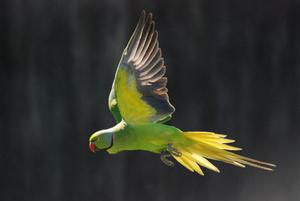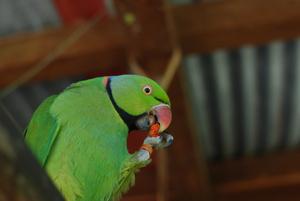Simon Tollington
Other projects
8 Feb 2010
A Novel Approach to Disease Management; Applying Immunoassays in the Field to Select Immunocompetent Individuals of the Endangered Mauritius Parakeet for Future Reintroduction
29 Nov 2011
The Analysis of Stable Isotopes to Determine the Value of Using Supplementary Feeding as a Conservation Management Tool
This project aims to quantify the exact contribution of supplemental food in the diet of individual parakeets. This information will enable managers to use this resource more efficiently to maximise the benefits whilst reducing any associated negative effects

In flight with crop full of pellets.
The Mauritius parakeet was recovered from the brink of extinction by an intensive conservation programme. Released juveniles were trained to take supplemental food from feeding hoppers, a technique that promoted population growth. Although the release of individuals ceased in 2005, supplemental food is still offered to the wild population but is not targeted, instead being supplied ad-libitum. Despite the obvious benefits, providing supplemental food to endangered species has been associated with negative consequences such as increased disease transmission, reliance, genetic adaptation, poor nutrition, and maintenance of poor quality individuals. These factors may inhibit long-term viability and resilience to environmental variation thereby compromising a species’ evolutionary potential and increasing its reliance on human intervention. Furthermore, a non-targeted approach to providing supplemental food could be regarded as an inefficient use of scarce financial resources

Eating a pellet.
A previous Rufford Small Grant (RSG 10518-2) was awarded to investigate the feasibility of using stable isotope analysis to quantify individual consumption of supplemental food from feather samples.
Measurements of stable isotopes are useful in determining the nutritional sources of organisms because the isotopic signatures of different dietary components are often distinct. For example, owing to the different photosynthetic pathways of terrestrial plants, signatures of stable carbon isotopes can be distinguished between C3, C4 and CAM primary producers. This variation in isotopic signature can then be detected in the tissues of consumers and used to infer the relative contribution of different food items to the diet of those consumers.
This preliminary study yielded extremely promising results; providing an estimate of the proportional dietary contribution of vegetation and supplemental food from 75 feathers. Furthermore, it revealed that many wild individuals consume as much supplemental food as those in captivity, despite access to areas of high quality forest. However, this initial study incorporated feather samples collected opportunistically from nestboxes and could therefore, not be associated with individual birds. This project will incorporate a larger sample of identified individuals from the wild population and encompass every known breeding attempt. Furthermore, feather samples will be collected during the non-breeding period in order to evaluate parakeets’ use of supplemental food outside the breeding season.
Additionally, samples of natural food sources during both the breeding, and non-breeding seasons will collected. This substantial sampling effort will reveal how individuals use supplemental food throughout the year, an unprecedented dataset for an endangered species.